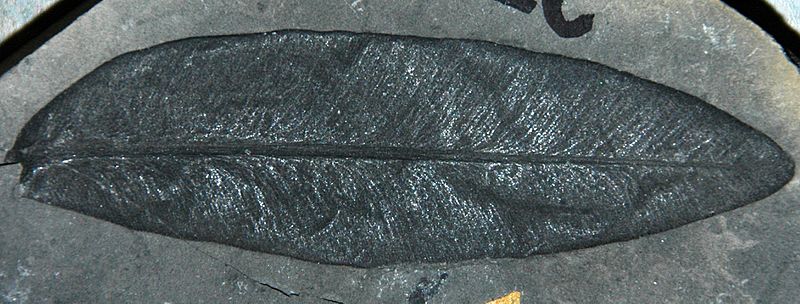Image: Glossopteris sp. (fossil leaf) (Permian; Antarctica) 1 (49063572172) (cropped)

Description: Glossopteris sp. - fossil leaf from the Permian of Antarctica (OSU QM 270-16-A, Orton Geology Museum, Ohio State University, Columbus, Ohio, USA) Plants are multicellular, photosynthetic eucaryotes. The oldest known land plant body fossils are Silurian in age. Fossil root traces of land plants are known back in the Ordovician. The Devonian was the key time interval during which land plants flourished and Earth experienced its first “greening” of the land. The earliest land plants were small and simple and probably remained close to bodies of water. By the Late Devonian, land plants had evolved large, tree-sized bodies and the first-ever forests appeared. In the plant fossil record, most leaf fossils are preserved by carbonization, which refers to flattened, dark-colored, carbon-rich films. Seen here is one of the most famous fossil plants in the world. This is a Permian-aged Glossopteris leaf from Antarctica. Glossopteris is a type of seed fern - the pteridosperms (although some paleobotanists do not consider it to be a seed fern at all). This fossil leaf provided some of the earliest evidence for the existence of an ancient supercontinent that Alfred Wegener dubbed "Pangaea". Glossopteris occurs in the southern continents: South America, Africa, India, Antarctica, and Australia. About one-quarter of a billion years ago, these continents were fused together and had vast Glossopteris forests. Glossopteris leaves are elongated and spatulate. Over 100 species have been named - most are defined based on morphometric differences in the leaf and in the size of the veination mesh. Glossopteris leaves have a distinctive veination pattern consisting of closed, reticulate veining or a patchwork veining. This is in contrast to the open veining style that is typical of the foliage of Paleozoic trees like Alethopteris. The central axis of a Glossopteris leaf has 4 or 5 main veins. The overall leaf can be small (a few centimeters) to long (half a meter). Most Glossopteris fossils are impressions, but some are carbonized compressions, as is the example seen here. Other parts of the Glossopteris plant, such as roots, pollen, reproductive structures, tree trunks, and roots, get different names, called form genera. Glossopteridalean roots are called Vertebraria - they can be up to ~1 foot in diameter. Their cross-sections show distinct wedges of wood and wedges of open space - chalcedony often fills up the empty spaces in Antarctic material. The woody wedges are secondary xylem and show growth increments ("growth rings"), but this does not necessarily imply seasonality - they could represent fluctuating water levels, with quicker growth periods. How is the plant supported by roots having lots of empty space? This is a biomechanical solution to support - have spaced bridges of wood, like steel I-beams used in building construction. Tree trunks of glossopteridaleans are log fossils with pitted tracheids - they look like conifer wood. Araucarioxylon is a trunk genus - it has a long range and only 5 or 6 identifying characteristics. Available fossils show that the overall Glossopteris plant had varied growth habits - it could be tree-like or bushy or vine-like. Fossil pollen grains are bisaccate and range in size from about 40 to 150 microns. Classification: Plantae, Pteridospermophyta, Glossopteridales, Glossopteridaceae Stratigraphy: unrecorded/undisclosed Permian unit Locality: undisclosed site in Antarctica (possibly in Queen Maud Land) See info. at: <a href="https://en.wikipedia.org/wiki/Glossopteris" rel="noreferrer nofollow">en.wikipedia.org/wiki/Glossopteris</a>
Title: Glossopteris sp. (fossil leaf) (Permian; Antarctica) 1 (49063572172) (cropped)
Credit: Glossopteris sp. (fossil leaf) (Permian; Antarctica) 1
Author: James St. John
Usage Terms: Creative Commons Attribution 2.0
License: CC BY 2.0
License Link: https://creativecommons.org/licenses/by/2.0
Attribution Required?: Yes
Image usage
The following page links to this image:

